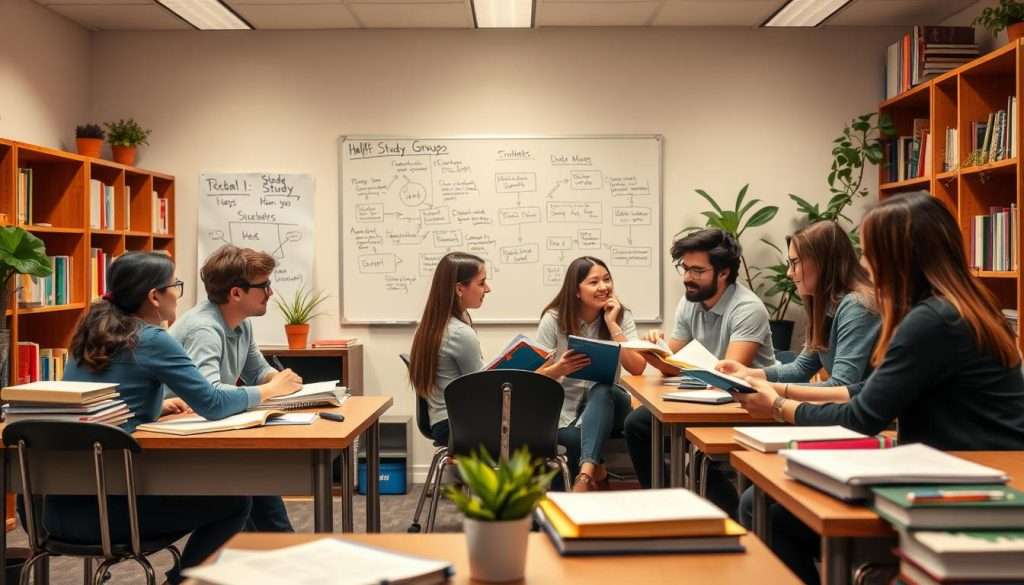Studying can sometimes feel like a chore. But, there’s a way to make it more enjoyable and effective. By forming study groups, you can tap into the power of collaborative learning. This way, you can share insights and stay motivated.
Working together with others helps you understand the course material better. It gives you a more nuanced perspective. This approach not only boosts your academic performance but also makes studying more engaging.
By joining or creating a study group, you’re taking a proactive step towards achieving academic success.
Key Takeaways
- Collaborative learning enhances understanding and retention of course material.
- Study groups provide motivation and help you stay on track.
- Sharing insights with others deepens your own knowledge.
- Working in a team prepares you for real-world collaborative environments.
- Effective study groups lead to improved academic performance.
The Power of Collaborative Learning
Group studying is more than just hanging out. It’s a smart way to learn. When students join a study group, they create a space for effective study techniques.
Why Study Groups Outperform Solo Studying
Studying in groups can change the game for many students. The group study benefits include more motivation, better retention, and clearer understanding of tough topics. Students learn from each other, filling in knowledge gaps.
- Motivation: Study groups keep you on track with your study plans.
- Accountability: Being in a group makes you more committed to studying.
- Diverse Perspectives: Different views help deepen your understanding of subjects.
Research-Backed Benefits of Group Learning
Research shows group learning is good. Students in study groups often do better in school. Study group tips from research include setting goals, assigning tasks, and good communication.
- Improved Academic Performance: Study groups often lead to higher grades.
- Better Understanding: Talking about complex topics helps you get them.
- Enhanced Retention: Teaching others what you know helps you remember it better.
How Collaborative Study Enhances Knowledge Retention
Collaborative study makes learning active, not passive. Teaching someone else helps you remember better. This active learning strengthens your memory.
Using effective study techniques in your group, like summarizing or making concept maps, boosts retention. The goal is to keep it interactive and engaging.
What Makes Study Groups Effective
A successful study group focuses on learning together. Students work better when they have a plan. We’ll look at what makes a study group great, common mistakes, and how to set goals.
Key Characteristics of Successful Study Groups
Good study groups have clear goals, meet regularly, and have roles for everyone. These traits help them stay focused and productive.
Having clear goals keeps the group on track. Regular meetings keep the energy up. Roles like a leader or note-taker help everyone know their part. This structure makes the group’s time together valuable.
Common Pitfalls to Avoid
Study groups can face challenges like unequal participation, unclear goals, and distractions. Knowing these issues helps groups avoid them.
Setting rules for participation ensures everyone contributes. Regularly checking goals keeps the group focused. This helps them stay on track.
Setting Clear Goals and Expectations
Clear goals and expectations are key for a study group’s success. They need to set both academic goals and behavioral expectations.
Academic Goals
Academic goals are about what the group wants to achieve. This could be better grades, mastering a subject, or exam prep. Specific goals keep the group motivated.
Behavioral Expectations
Behavioral expectations are about how members should act. This means being on time, prepared, and respectful. Good behavior keeps the group positive and productive.
By following these tips, you can make a study group that’s effective and fun. Great study groups have clear goals, respect each other, and work together.
How to Form the Perfect Study Group
Creating a great study group is more than just getting together with friends. It’s about building a team that helps everyone learn better. To make a study group that really works, you need to think about a few important things.
Identify Potential Group Members
First, find people who want to learn and succeed as much as you do. Look for classmates who share your goals. You can also post on social media or use student forums to find others who are interested.
When picking group members, think about their strengths and weaknesses. Also, consider how they learn best. This helps make sure your group has a good mix of skills and learning styles.
Determine the Ideal Group Size
The number of people in your study group matters a lot. Studies say 3-5 members is the best size. This size offers a good mix of ideas without being too hard to manage.
If your group is too small, you might miss out on different views. But if it’s too big, it can be hard to work together and make decisions.
Establish Group Rules and Guidelines
After you pick your group members, make sure you all agree on some rules. Set clear expectations for who should be there, how to talk, and how often to meet. Having a regular schedule helps everyone stay on track.
These rules help avoid confusion and make sure everyone knows what’s expected. It keeps your group working well together.
Create a Group Contract
A group contract is a great way to outline what each member should do. It can cover things like when to meet, what to prepare, and how to handle problems.
Sample Contract Template
Here’s a simple template to help you get started on your group contract:
| Expectation | Responsibility | Consequence for Not Meeting |
|---|---|---|
| Attend all scheduled meetings | All members | Discuss and agree on a plan for catching up |
| Come prepared to each meeting | All members | Be prepared to explain why and how to improve |
| Actively participate in discussions | All members | Encourage quieter members to contribute |
By following these steps and making a detailed group contract, you can make sure your study group is successful. It will be a place where everyone can learn and grow together.
Structuring Your Study Groups for Maximum Effectiveness
To get the most out of your study group, it’s crucial to structure your sessions effectively. A well-structured study group can make a big difference in your learning. It helps you stay focused, manage your time well, and remember information better.
Design Productive Study Sessions
Designing productive study sessions is key to making your study group effective. Start by creating a clear plan for each session. Set specific goals and identify the materials you need to cover. This ensures your study group stays on track and uses your time wisely.
To design productive study sessions:
- Set clear objectives for what you want to achieve in each session.
- Prepare any necessary materials in advance, such as readings or practice problems.
- Establish a routine or agenda to keep the group focused.
Implement Time Management Techniques
Effective time management is crucial for your study group’s success. Techniques like the Pomodoro Technique can help. It involves working in focused 25-minute increments, followed by a 5-minute break, to keep momentum and avoid burnout.
Other time management strategies include:
- Creating a schedule and sticking to it.
- Prioritizing tasks based on importance and urgency.
- Minimizing distractions during study sessions.
Assign and Rotate Roles
Assigning roles to group members helps distribute responsibilities and ensures smooth operation. Common roles include the facilitator, note-taker, and timekeeper. Rotating these roles keeps things fresh and helps each member develop different skills.
Facilitator Responsibilities
The facilitator leads the study group, keeps discussions on track, and ensures objectives are met. This role requires strong leadership and organizational skills.
Note-Taker Duties
The note-taker records important information discussed during the session. This includes key concepts, questions, and action items. It helps in reviewing material later and ensures no important details are missed.
Timekeeper Function
The timekeeper keeps the study group on schedule. They ensure you stay within your allocated time for each task or discussion topic. This helps maintain a productive pace and covers all necessary material.
Essential Study Group Activities and Methods
Effective study groups use many activities to improve learning together. They use different methods to make learning fun and supportive. This helps everyone do better in school.
Question and Answer Techniques
One great activity is asking and answering questions. Start by picking a topic for each group member to prepare questions on. Then, everyone answers the questions together.
- Use flashcards for questions and answers.
- Take turns explaining things to each other.
- Ask follow-up questions to clear up any confusion.
Group Discussion and Debate Strategies
Group discussions and debates help you understand topics better. Debating or discussing complex issues helps everyone learn more. Here are some tips for good discussions:
- Choose topics or questions ahead of time.
- Set rules for respectful debate.
- Make sure everyone gets a chance to speak.
Collaborative Note-Taking Methods
Working together on notes is very helpful. Using digital tools for real-time note-taking is a good idea. This way, everyone can learn more together.
- Share notes before or after meetings.
- Use apps for everyone to work on notes together.
- Compare notes to find important points.
Teaching Concepts to Peers
Teaching others helps you learn better too. When everyone teaches each other, they all understand more.
The Feynman Technique in Groups
The Feynman Technique is about explaining things simply. Have each person explain a concept as if teaching it for the first time. This makes things clear and finds any mistakes.
By using these activities, study groups can be fun and helpful. They help students do well in school and understand their studies better.
Digital Tools and Resources for Study Groups
Remote learning has made digital tools key for study groups. They help keep everyone connected and organized. These tools also make learning better.
Virtual Meeting Platforms for Remote Collaboration
Virtual meeting platforms have changed how study groups work together. Tools like Zoom and Google Meet let members join from anywhere. This makes setting up study sessions easier.
Key Features to Look for:
- High-quality video and audio
- Screen sharing capabilities
- Recording options for later review
- Breakout rooms for smaller group discussions
Document and Resource Sharing Solutions
It’s important for study groups to share documents and resources. Google Drive and Dropbox make this easy. They allow for smooth sharing and working together on documents.
| Platform | Key Features | Storage Capacity |
|---|---|---|
| Google Drive | Real-time collaboration, automatic saving | 15GB free storage |
| Dropbox | Easy file sharing, version control | 2GB free storage |
Study Apps and Software for Group Learning
Many study apps help groups learn together. These apps have features that make studying better.
Scheduling and Organization Tools
Tools like Trello and Asana help groups stay on track. They manage tasks and plan study sessions.
Trello’s board-based system is great for seeing tasks and deadlines.
Collaborative Study Applications
Apps like Quizlet and StudyBlue have group study features. They include sharing flashcards and group quizzes.

Using these digital tools, study groups can improve their learning. They stay organized and reach their goals better.
Overcoming Common Study Group Challenges
Creating an effective study group is more than just bringing people together. It requires a strategic plan to tackle common obstacles. As you work together, you’ll face issues that can affect your group’s success.
Handling Unequal Participation
One big challenge is when not everyone participates equally. To fix this, assign roles like leader, note-taker, or discussion starter. This way, everyone has a part to play and feels responsible.
Also, set clear goals and expectations at the start. This helps everyone know what to aim for and how to work together.
Managing Conflicts
Conflicts can happen, but they shouldn’t stop your study group. To handle them, create a rule for respectful talk. When disagreements pop up, aim to solve the problem, not place blame.
Active listening is crucial. Make sure everyone gets a chance to be heard before moving on.
Maintaining Focus and Motivation
Keeping your study group focused and motivated is key. Set specific, achievable goals for each session. Break down big tasks into smaller ones and celebrate your wins.
Regular breaks can also keep energy up and prevent burnout.
Accommodating Different Learning Styles
Everyone learns differently, and a good study group adapts to these differences. Some might prefer visual, auditory, or hands-on learning. Mix up your teaching methods to reach everyone.
By tackling these common challenges, you can build a study group that boosts everyone’s academic success. With these strategies, you’ll unlock the power of learning together.
Advanced Study Groups Strategies for Different Subjects
Success in a study group depends on how well it adapts to the subject. Each subject needs its own strategy to boost learning. We’ll look at advanced methods for various subjects, helping you fine-tune your group’s approach for the best results.
STEM Subject Techniques
STEM subjects (Science, Technology, Engineering, and Mathematics) need hands-on problem-solving and a deep grasp of complex ideas. Study groups can use specific strategies to excel in these areas.
Problem-Solving Approaches
One effective method is to solve problems together. Take turns solving problems on a whiteboard while explaining your thought process. This way, you can spot common mistakes and strengthen your understanding. As Polya said, “If there is a problem you can’t solve, then there is an easier problem you can solve: find it.” Effective problem-solving breaks down complex issues into manageable parts.
“The only way to do great work is to love what you do.” – Steve Jobs
Formula and Concept Mastery
To master STEM formulas and concepts, make flashcards or concept maps together. These visual aids help remember key formulas and see how concepts connect. Quiz each other with these flashcards to improve memorization.

Humanities and Social Sciences Methods
Humanities and social sciences focus on understanding historical contexts, analyzing texts, and developing critical thinking. Study groups can benefit from discussion-based methods.
- Discuss historical events or literary works in depth, exploring different interpretations.
- Create timelines or concept maps to visualize historical periods or literary movements.
- Practice essay writing together, focusing on thesis statement development and argumentation.
Language Learning in Group Settings
Language learning excels in group settings where practice and interaction are key. Study groups can:
- Engage in conversational practice, switching between the target language and your native language.
- Use language learning apps together, exploring different features and practicing in pairs.
- Create and act out scenarios or role-plays to practice real-life language usage.
Test Preparation Strategies
Test preparation is vital for academic success, regardless of the subject. Study groups can improve their test prep by:
- Creating practice tests together based on past exams or predicted topics.
- Developing a “test-taking strategy” session, focusing on time management and question-answering techniques.
- Conducting review sessions after practice tests to identify areas for improvement.
By tailoring your study group strategies to your subject’s needs, you can greatly improve your learning and academic results. Remember, being flexible with your approach is crucial for a study group’s success.
Conclusion
By now, you’ve seen how study groups can change your academic life. Collaborative learning is more than just a trend; it’s a proven way to succeed in school. Working together with your classmates, you gain a lot of knowledge, see things from new angles, and stay driven.
To make the most of study groups, set clear goals and have productive meetings. Use digital tools to help your group work better together. This way, you’ll not only learn more but also improve your teamwork and communication skills.
So, bring your classmates together and create a study group that suits you. With the right approach to collaborative learning, you’ll be on your way to success in school. You’ll make the most of your time in education.

